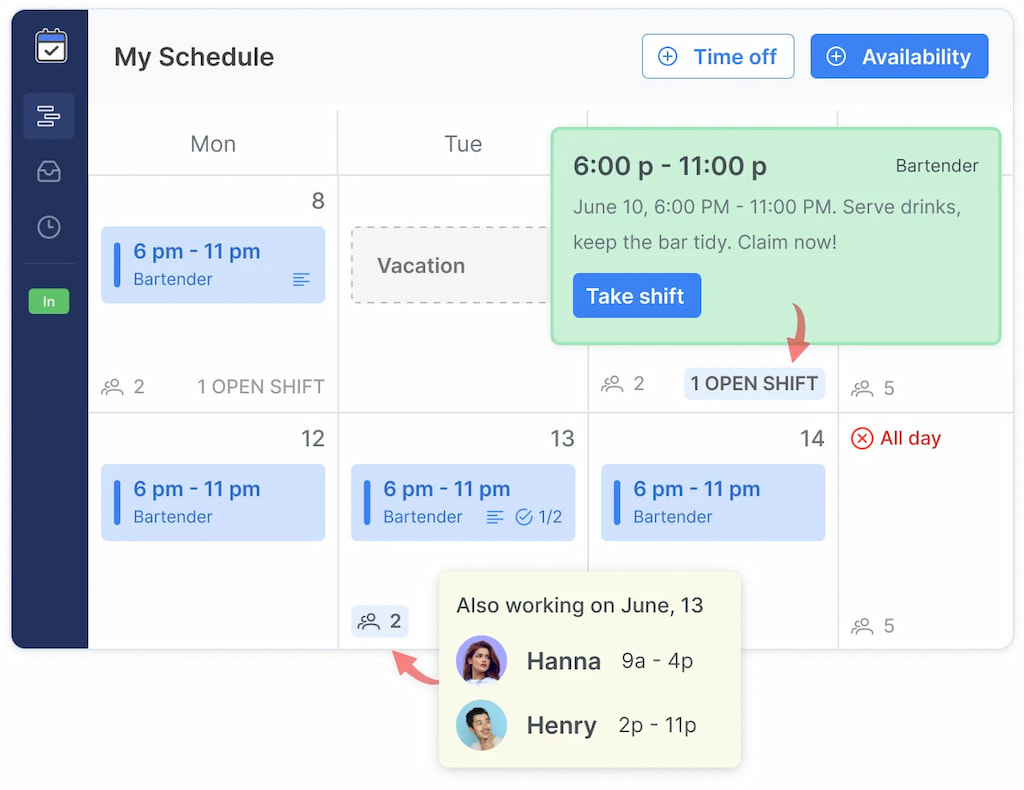Reducing No-Shows With Better Shift Communication (Because Your Team Isn’t Psychic)

You know that sinking feeling when someone doesn’t show up for their shift? You check your phone. No text. No call. Just a mysterious absence that leaves your team scrambling and you wondering if your schedule is printed in invisible ink. The truth is, no-calls no-shows aren’t always about bad employees. More often than not, they’re about bad communication. If your team finds out they’re working the same way they find out Mercury’s in retrograde—randomly and too late to do anything about it—it’s no wonder your coverage falls apart. Let’s talk about the tools (and mindset) you need to make no-shows the rare exception, not a weekly ritual. Learn how reducing no-shows with better shift communication really works!
Why No-Shows Happen (Spoiler: It’s Not Just Flaky People)
Sure—sometimes people are just unreliable. But if it’s happening often, it’s not just a “people problem.” It’s a system failure.
The real causes
- ❗ Last-minute schedule changes that cause confusion
- 🔕 Lack of reminders or real-time updates
- 👀 No clear view of who’s working when
- 🤷♂️ Unclear shift ownership—“Was that my shift?”
- 🔄 Silent swaps between employees that managers never catch
Sound familiar?
Then it’s time to upgrade your communication stack.
Texting Isn’t a System—It’s a Stopgap
Relying on texts, group chats, or post-it notes taped to the staff fridge is not communication. It’s noise. And noise leads to:
1️⃣ Missed messages
2️⃣ Double-booked shifts
3️⃣ “I didn’t know I was scheduled” excuses

It also creates an exhausting cycle for managers, who become de facto customer service reps for their own team’s schedule.
Shift Communication: Clear, Centralized, and Automatic
🟢 Clear
Everyone knows what shift they’re working, when it changed, and who they’re working with.
📍 Centralized
All shift info, updates, and messages live in one platform—not scattered across 5 apps and a whiteboard.
⚙️ Automatic
Reminders go out without you lifting a finger. Updates are real-time. Accountability is built in.
🚀 This isn’t wishful thinking. It’s how modern teams already operate—with the right tech.
How In-App Messaging Solves the “I Didn’t Know” Problem
💬 With in-app shift messaging, your team doesn’t have to chase information.
- 📲 Employees get pinged when shifts are posted, changed, or claimed
- 🔄 Shift swaps include message threads and approvals
- 📝 Notes can be attached to shifts (“Bring black shoes,” “Covering for Jamie,” “New promo today”)
📅 It’s like having a group chat that’s actually organized, useful, and tied directly to the schedule.
No more:
“I didn’t see the message.”
“Nobody told me I was on the schedule.”
“I thought we agreed I wasn’t working Thursdays?”
✅ They see it. It’s in the app. No excuses.
Real-Time Updates = Real Accountability
📊 Here’s a fun stat: A study from the Workforce Institute found that 63% of shift workers say they’ve missed work because of scheduling miscommunication.
When your scheduling platform sends real-time notifications, you close the gap between “manager assigns shift” and “employee knows they’re working.”
Whether it’s a new shift, a swap approval, or a time change, your team gets notified immediately, not when they check their email 3 days later.
💡 Pro tip: Choose a system that lets you push mobile alerts. If it’s not on their phone, it’s already forgotten.
Visibility = Ownership
👀 The more your team can see the schedule, the more they can plan around it—and the less you have to chase them.
Visibility means that they can:
- 👥 See who they’re working with
- 🕵️♂️ Check coverage gaps and volunteer to help
- 📋 Verify open shifts, swap status, and time-off approvals—all in one place
🔑 No surprises. No “I didn’t realize today was my shift.” Visibility builds ownership. Ownership reduces no-shows.
Let’s Get Practical: What to Look for in a Shift Communication Tool
If you’re evaluating software (and you should be), don’t get distracted by shiny dashboards. Look for tools that nail the basics:
| Must-have feature | Why it matters |
|---|---|
| In-app messaging | So your team stops texting you during dinner |
| Mobile push notifications | So shift info actually gets seen |
| Shift-specific notes | Context = clarity |
| Real-time schedule sync | Because even a 5-minute delay can cost you |
| Visibility across teams | Everyone knows what’s happening |
| Shift ownership logs | See who accepted, swapped, or bailed |
Spoiler: Shifts by Everhour has all of this—and won’t make your team sit through a 90-minute webinar to use it.
Case in Point: The $200 Coffee Run
☕ Let’s say Sam doesn’t show up for their 7 AM shift at a busy café. They “forgot.” The manager didn’t send a reminder. The schedule changed. Miscommunication. You get it.
By 9 AM, you’ve:
- 🚶♂️ Lost 40+ customers to long lines
- 🔥 Burned out your remaining staff
- 💸 Missed $200+ in sales
- 🚨 Added another stressful fire drill to your week
All because one message didn’t go through.
💥 Multiply that by a few no-shows per month and you’re not just losing hours—you’re losing real revenue.
Shifts by Everhour: Built for Schedule Clarity (Not Corporate Confusion)
Shifts by Everhour was built for teams who need real communication, not corporate jargon. Here’s what it gives you:
- Instant shift updates and notifications

- Messaging is built right into each shift
- Open shift claiming and swap visibility

- Visibility for everyone—from employees to
- Manager approvals without chaos
No more passive-aggressive group texts. No more guessing games. Just real, reliable, modern communication.
Wrap-Up: The Best Schedule in the World Is Useless If No One Sees It
Building the perfect schedule isn’t enough—if your team doesn’t get the right information at the right time, no-shows will still happen. The solution isn’t micromanagement. It’s about creating a system everyone can trust:
- Clear shift details
- Real-time updates
- Simple handoffs
When you get communication right, no-shows drop, accountability rises, and you get your time back.
Ask yourself: Is your schedule clear enough to prevent no-shows, or just clear enough to cause confusion? If it’s the latter, it’s time to upgrade. Start communicating better. Watch your no-shows disappear.
🔎 Read what users say about Shifts:
“Availability tracking on Shifts has been a lifesaver. It ensures we always have the right people on the job at the right time. It’s an indispensable part of our daily operations” David
“Shifts app has not only improved but revolutionized our daily operations. It’s more than just an employee scheduling solution; it’s an essential part of our business toolkit.” Laura
“Shifts app has been a game-changer for us. The custom fields feature allows us to track specific details effortlessly. It has streamlined our employee management process, making our lives much easier.” Emily
